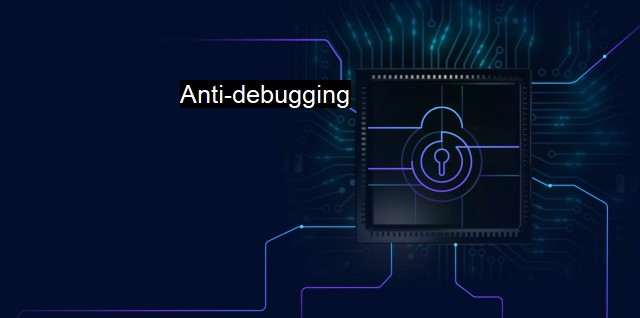What is Anti-debugging?
Anti-Debugging Techniques: Evading Detection and Covertly Spreading Malware for Cybercriminals
Anti-debugging refers to several techniques used predominantly by malicious software to actively or passively avoid being detected or inspected by detection and debugging tools. Derived from the world of cybersecurity, these techniques usually include various forms of code obfuscation and cloaking. Anti-debugging is a critical topic as new threats continue to surface, challenging not only antivirus software developers but also professionals involved in maintaining data security standards.In the broader scope of cybersecurity, anti-debugging may be perceived as the strategies it incorporates to protect its code from probing and inspection, maintaining its functionality without getting noticed. When an application or process runs on a computer system, debugging tools can inspect the process by watching for specific behaviors or anomalies which may be indicative of potential vulnerabilities or harmful activities. Anti-debugging techniques, on the entire, aim at circumventing these inspection procedures to protect their malicious capabilities from being detected.
This can be particularly problematic for antivirus software and tools, which rely heavily on being able to inspect and debug processes to identify harmful activities. To fight against anti-debugging measures, antivirus developers continuously come up with adaptive solutions to keep up with the constantly evolving cyber menace.
Anti-debugging comes in various shapes and sizes; the most typical approach is to make use of specific constructs within the computer’s operating system. are a method called API-based anti-debugging involves adopting certain system calls to manipulate normal system behavior and prevent a debugger’s operations from effectively inspecting a running process.
Another common anti-debugging technique is Exception-based anti-debugging. This technique tricks the debugger into thinking a system error (or ‘exception’) has occurred, causing the debugger to cease inspections incorrectly, due to a false diagnosis.
Techniques based on time artificialities hinder inspection by delaying or stalling the execution of specific functions or processes. Such delays are usually remarkably lengthy, causing a debugging tool to halt inspection due to inefficiency or time-out, while the hidden operation continues covertly.
Hardware and register-based techniques are used to manipulate the debugging process subtly. Certain registers in a computer’s processor can be employed to detect and disrupt the debugging tools. A more intricate implementation like pointer encryption can make the debugging process compute intensive and impractical.
Newer, more innovative anti-debugging strategies are consistently hitting the scene. One such technique, referred-to as a polymorphic engine, makes use of algorithmic variation, which lets a software entity almost continually change its code as it runs. By undetectably changing its form and characteristics, these polymorphic entities present a significant challenge to conventional debugging and detection tools.
Anti-debugging practices do not solely exist to propagate malicious activity. Legitimate commercial software developers also use them to protect intellectual property. their primary use remains in the spot of cybersecurity, where these techniques present a unique set of challenges for the cybersecurity community.
To tackle the rising tide of threats involves ever-evolving anti-debugging tools, developers and cybersecurity is adapting various tactics. More sophisticated runtime checks, interactive debugging, kernel debugging, and machine learning adaptative analyzes approaches are among those strategies playing a key role in combating the stealth of anti-debugging techniques.
Cybersecurity is a continually developing battlefield. Antivirus developers have to stay ahead in the race to identify and counteract the ever-growing complexities and capabilities of anti-debugging strategy. One thing is sure: with the disruptiveness and seriousness that these threats hold, cybersecurity remains one of the most critical aspects of modern-day digital life, and global efforts in this area will have to always remain one step ahead. As confrontations unfold between attackers and defenders in the world of codes, whether the greater force will gain the upper hand in this virtual war of cybersecurity is yet to be seen.

Anti-debugging FAQs
What is anti-debugging?
Anti-debugging is a technique used in cybersecurity to prevent the reverse engineering of software or malware by detecting and thwarting attempts to analyze or modify the code during runtime.Why is anti-debugging important in cybersecurity?
Anti-debugging is important in cybersecurity because cybercriminals use advanced techniques to analyze and modify software or malware to evade detection by antivirus programs. Anti-debugging helps to prevent reverse engineering attempts and makes it difficult for attackers to analyze the code and modify it to bypass antivirus detection.What are some common anti-debugging techniques used in cybersecurity?
Some common anti-debugging techniques used in cybersecurity include code obfuscation, debugger detection, memory protection, and code integrity checks. These techniques make it difficult for attackers to analyze or modify the code during runtime, thereby protecting the software or malware from detection and analysis.Can anti-debugging be bypassed?
Yes, anti-debugging can be bypassed by experienced attackers who use advanced techniques like kernel-level debugging, hypervisor-based debugging, or dynamic code modification. However, anti-debugging makes it difficult for attackers to analyze or modify the code during runtime, thereby increasing the level of protection against cyber threats.Related Topics
Reverse engineering Obfuscation techniques Code obfuscation Code injection Code signing
| | A | | | B | | | C | | | D | | | E | | | F | | | G | | | H | | | I | | | J | | | K | | | L | | | M | |
| | N | | | O | | | P | | | Q | | | R | | | S | | | T | | | U | | | V | | | W | | | X | | | Y | | | Z | |
| | 1 | | | 2 | | | 3 | | | 4 | | | 7 | | | 8 | | |||||||